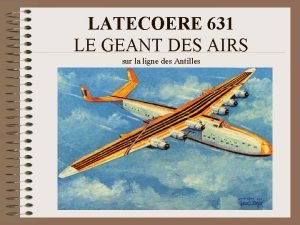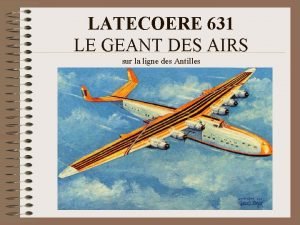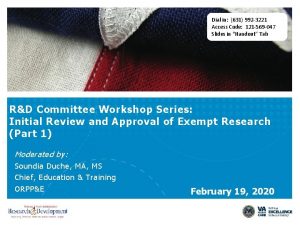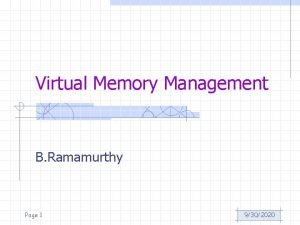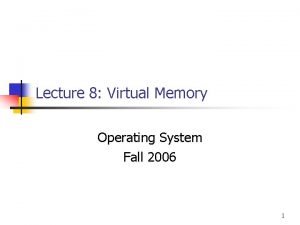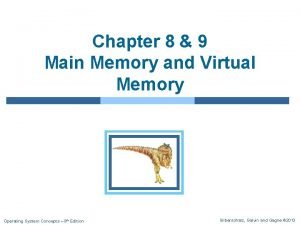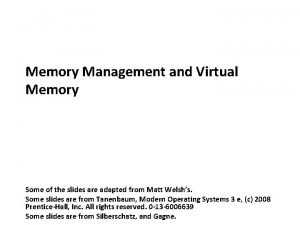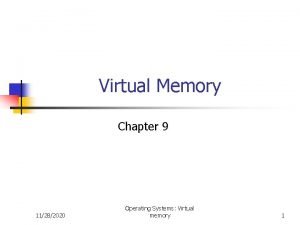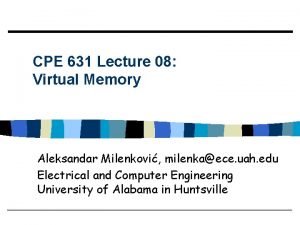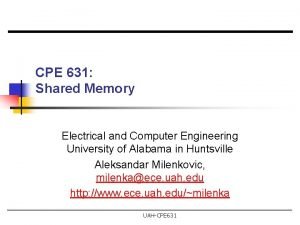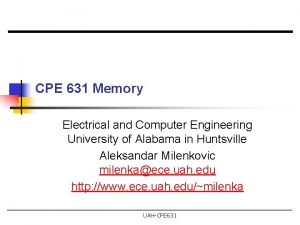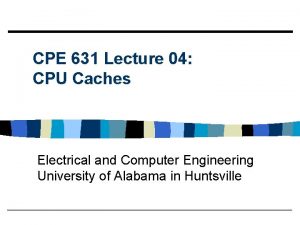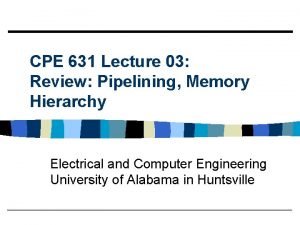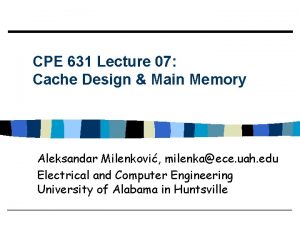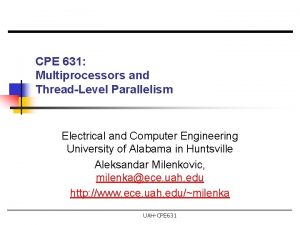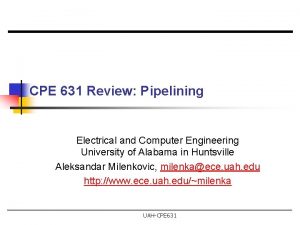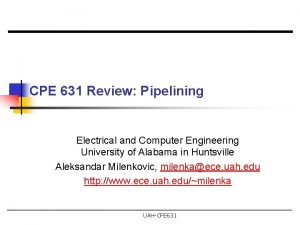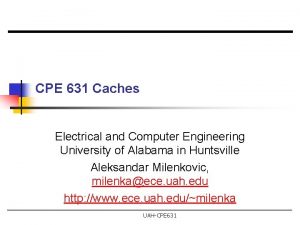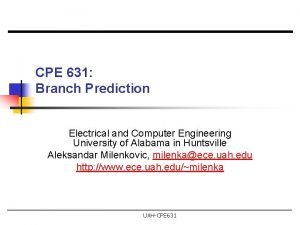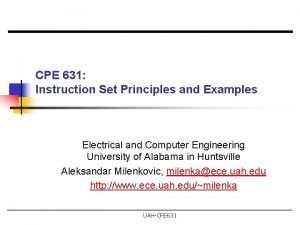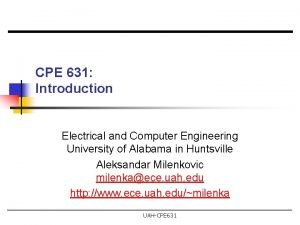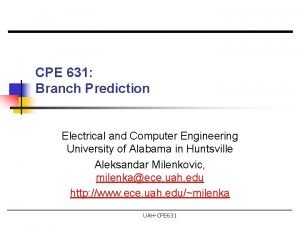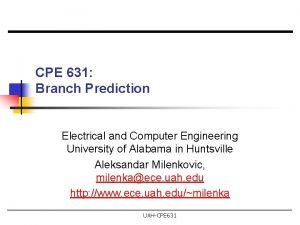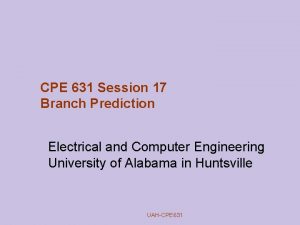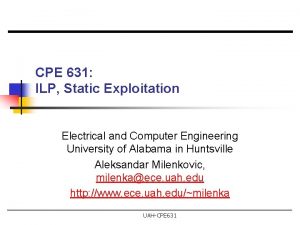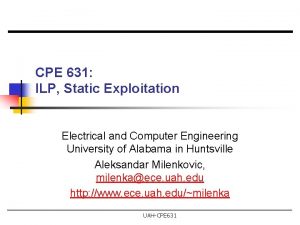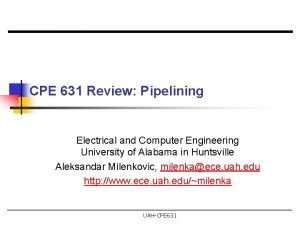CPE 631 Lecture 09 Virtual Memory Electrical and
































- Slides: 32

CPE 631 Lecture 09: Virtual Memory Electrical and Computer Engineering University of Alabama in Huntsville UAH-CPE 631

Virtual Memory: Topics CPE 631 AM ® Why virtual memory? ® Virtual to physical address translation ® Page Table ® Translation Lookaside Buffer (TLB) 11/1/2021 UAH-CPE 631 2

Another View of Memory Hierarchy Upper Level CPE 631 AM Thus far { Next: Virtual Memory { Regs Instructions, Operands Cache Blocks L 2 Cache Blocks Memory Pages Disk Files Tape 11/1/2021 Faster UAH-CPE 631 Larger Lower Level 3

Why Virtual Memory? CPE 631 AM ® Today computers run multiple processes, each with its own address space ® Too expensive to dedicate a full-address-space worth of memory for each process ® Principle of Locality allows caches to offer speed of cache memory with size of DRAM memory ® DRAM can act as a “cache” for secondary storage (disk) Virtual Memory ® ® Virtual memory – divides physical memory into blocks and allocate them to different processes 11/1/2021 UAH-CPE 631 4

Virtual Memory Motivation CPE 631 AM ® Historically virtual memory was invented when programs became too large for physical memory ® Allows OS to share memory and protect programs from each other (main reason today) ® Provides illusion of very large memory sum of the memory of many jobs greater than physical memory ® allows each job to exceed the size of physical mem. ® ® Allows available physical memory to be very well utilized ® Exploits memory hierarchy to keep average access time low 11/1/2021 UAH-CPE 631 5

Mapping Virtual to Physical Memory CPE 631 AM ® Program with 4 pages (A, B, C, D) ® Any chunk of Virtual Memory assigned to any chuck of Physical Memory (“page”) Virtual Memory 0 4 KB 8 KB 12 KB Physical Memory 0 4 KB A B C D Disk 8 KB D B 12 KB 16 KB A 20 KB C 24 KB 28 KB 11/1/2021 UAH-CPE 631 6

Virtual Memory Terminology CPE 631 AM ® Virtual Address ® address used by the programmer; CPU produces virtual addresses ® Virtual Address Space ® collection of such addresses ® Memory (Physical or Real) Address ® address of word in physical memory ® Memory mapping or address translation ® process of virtual to physical address translation ® More on terminology ® Page or Segment Block ® Page Fault or Address Fault Miss 11/1/2021 UAH-CPE 631 7

Comparing the 2 levels of hierarchy Parameter CPE 631 Block/Page AM Hit time L 1 Cache Virtual Memory 16 B – 128 B 4 KB – 64 KB 1 – 3 cc 50 – 150 cc Miss Penalty 8 – 150 cc (Access time) 6 – 130 cc (Transfer time) 2 – 20 cc 1 M – 10 M cc (Page Fault ) 800 K – 8 M cc 200 K – 2 M cc Miss Rate 0. 1 – 10% 0. 00001 – 0. 001% Placement: DM or N-way SA Fully associative (OS allows pages to be placed anywhere in main memory) Address Mapping 25 -45 bit physical address to 14 -20 bit cache address 32 -64 bit virtual address to 25 -45 bit physical address Replacement: LRU or Random (HW cntr. ) LRU (SW controlled) Write Policy WB or WT WB 11/1/2021 UAH-CPE 631 8

Paging vs. Segmentation CPE 631 AM ® Two classes of virtual memory ® Pages - fixed size blocks (4 KB – 64 KB) ® Segments - variable size blocks (1 B – 64 KB/4 GB) ® Hybrid approach: Paged segments – a segment is an integral number of pages Code Data Paging Segmentation 11/1/2021 UAH-CPE 631 9

Paging vs. Segmentation: Pros and Cons CPE 631 AM Page Segment Words per address One Two (segment + offset) Programmer visible? Invisible to AP May be visible to AP Replacing a block Trivial (all blocks are the same size) Hard (must find contiguous, variable-size unused portion Memory use inefficiency Internal fragmentation External fragmentation (unused portion of (unused pieces of main page) memory) Efficient disk traffic Yes (adjust page size to balance access time and transfer time) 11/1/2021 UAH-CPE 631 Not always (small segments transfer few bytes) 10

Virtual to Physical Addr. Translation CPE 631 AM Program operates in its virtual address space virtual address (inst. fetch load, store) physical HW mapping address (inst. fetch load, store) Physical memory (incl. caches) ® Each program operates in its own virtual address space ® Each is protected from the other ® OS can decide where each goes in memory ® Combination of HW + SW provides virtual physical mapping 11/1/2021 UAH-CPE 631 11

Virtual Memory Mapping Function CPE 631 AM Virtual Address . . . 31 10 9 Virtual Page No. 0 . . . Offset translation Physical Address 29 . . . 10 9 . . . 0 Phys. Page No. Offset ® Use table lookup (“Page Table”) for mappings: Virtual Page number is index ® Virtual Memory Mapping Function Physical Offset = Virtual Offset ® Physical Page Number (P. P. N. or “Page frame”) = Page. Table[Virtual Page Number] ® 11/1/2021 UAH-CPE 631 12

Address Mapping: Page Table CPE 631 AM Virtual Address: virtual page no. offset Page Table Valid Page Table Base Reg index into Page Table Access Rights Physical Page Number . . . physical page no. offset Physical Address 11/1/2021 UAH-CPE 631 13

Page Table CPE 631 AM ®A page table is an operating system structure which contains the mapping of virtual addresses to physical locations ® There are several different ways, all up to the operating system, to keep this data around ® Each process running in the operating system has its own page table “State” of process is PC, all registers, plus page table ® OS changes page tables by changing contents of Page Table Base Register ® 11/1/2021 UAH-CPE 631 14

Page Table Entry (PTE) Format CPE 631 AM ® Valid bit indicates if page is in memory ® ® OS maps to disk if Not Valid (V = 0) Contains mappings for every possible virtual page Page Table ® V. A. R. P. P. T. Valid Access Rights Physical Page Number V. A. R. P. P. T . . P. T. E. If valid, also check if have permission to use page: Access Rights (A. R. ) may be Read Only, Read/Write, Executable 11/1/2021 UAH-CPE 631 15

Virtual Memory Problem #1 CPE 631 AM ® Not enough physical memory! ® Only, say, 64 MB of physical memory ® N processes, each 4 GB of virtual memory! ® Could have 1 K virtual pages/physical page! ® Spatial Locality to the rescue ® Each page is 4 KB, lots of nearby references ® No matter how big program is, at any time only accessing a few pages ® “Working Set”: recently used pages 11/1/2021 UAH-CPE 631 16

VM Problem #2: Fast Address Translation CPE 631 AM ® PTs are stored in main memory Every memory access logically takes at least twice as long, one access to obtain physical address and second access to get the data ® Observation: locality in pages of data, must be locality in virtual addresses of those pages Remember the last translation(s) ® Address translations are kept in a special cache called Translation Look-Aside Buffer or TLB ® TLB must be on chip; its access time is comparable to cache 11/1/2021 UAH-CPE 631 17

Typical TLB Format CPE 631 AM Virtual Addr. ® ® ® Physical Addr. Dirty Ref Valid Access Rights Tag: Portion of virtual address Data: Physical Page number Dirty: since use write back, need to know whether or not to write page to disk when replaced Ref: Used to help calculate LRU on replacement Valid: Entry is valid Access rights: R (read permission), W (write perm. ) 11/1/2021 UAH-CPE 631 18

Translation Look-Aside Buffers CPE 631 AM ® TLBs usually small, typically 128 - 256 entries ® Like any other cache, the TLB can be fully associative, set associative, or direct mapped Processor VA hit PA TLB Lookup miss Cache miss Main Memory hit Data Translation 11/1/2021 UAH-CPE 631 19

TLB Translation Steps CPE 631 AM ® Assume 32 entries, fully-associative TLB (Alpha AXP 21064) ® 1: Processor sends the virtual address to all tags ® 2: If there is a hit (there is an entry in TLB with that Virtual Page number and valid bit is 1) and there is no access violation, then ® 3: Matching tag sends the corresponding Physical Page number ® 4: Combine Physical Page number and Page Offset to get full physical address 11/1/2021 UAH-CPE 631 20

What if not in TLB? CPE 631 AM ® Option 1: Hardware checks page table and loads new Page Table Entry into TLB ® Option 2: Hardware traps to OS, up to OS to decide what to do When in the operating system, we don't do translation (turn off virtual memory) ® The operating system knows which program caused the TLB fault, page fault, and knows what the virtual address desired was requested ® So it looks the data up in the page table ® If the data is in memory, simply add the entry to the TLB, evicting an old entry from the TLB ® 11/1/2021 UAH-CPE 631 21

What if the data is on disk? CPE 631 AM ® We load the page off the disk into a free block of memory, using a DMA transfer ® Meantime we switch to some other process waiting to be run ® When the DMA is complete, we get an interrupt and update the process's page table ® So when we switch back to the task, the desired data will be in memory 11/1/2021 UAH-CPE 631 22

What if we don't have enough memory? CPE 631 AM ® We chose some other page belonging to a program and transfer it onto the disk if it is dirty ® If clean (other copy is up-to-date), just overwrite that data in memory ® We chose the page to evict based on replacement policy (e. g. , LRU) ® And update that program's page table to reflect the fact that its memory moved somewhere else 11/1/2021 UAH-CPE 631 23

Page Replacement Algorithms CPE 631 AM ® First-In/First Out ® in response to page fault, replace the page that has been in memory for the longest period of time ® does not make use of the principle of locality: an old but frequently used page could be replaced ® easy to implement (OS maintains history thread through page table entries) ® usually exhibits the worst behavior ® Least Recently Used ® selects the least recently used page for replacement ® requires knowledge of past references ® more difficult to implement, good performance 11/1/2021 UAH-CPE 631 24

Page Replacement Algorithms (cont’d) CPE 631 AM ® Not Recently Used (an estimation of LRU) ®A reference bit flag is associated to each page table entry such that Ref flag = 1 - if page has been referenced in recent past ® Ref flag = 0 - otherwise ® ® If replacement is necessary, choose any page frame such that its reference bit is 0 ® OS periodically clears the reference bits ® Reference bit is set whenever a page is accessed 11/1/2021 UAH-CPE 631 25

Selecting a Page Size CPE 631 AM ® Balance forces in favor of larger pages versus those in favoring smaller pages ® Larger page Reduce size PT (save space) ® Larger caches with fast hits ® More efficient transfer from the disk or possibly over the networks ® Less TLB entries or less TLB misses ® ® Smaller page ® better conserve space, less wasted storage (Internal Fragmentation) ® shorten startup time, especially with plenty of small processes 11/1/2021 UAH-CPE 631 26

VM Problem #3: Page Table too big! CPE 631 AM ® Example ® 4 GB Virtual Memory ÷ 4 KB page => ~ 1 million Page Table Entries => 4 MB just for Page Table for 1 process, 25 processes => 100 MB for Page Tables! ® Problem gets worse on modern 64 -bits machines ® Solution is Hierarchical Page Table 11/1/2021 UAH-CPE 631 27

Page Table Shrink CPE 631 AM ® Single Page Table Virtual Address Page Number Offset 20 bits ® Multilevel Page Table Virtual Address Super Page Number 10 bits 12 bits Page Number Offset 12 bits 10 bits ® Only have second level page table for valid entries of super level page table ® If only 10% of entries of Super Page Table are valid, then total mapping size is roughly 1/10 -th of single level page table 11/1/2021 UAH-CPE 631 28

2 -level Page Table CPE 631 AM 2 nd Level Page Tables Physical Memory Virtual Memory Super Page. Table Stack 64 MB Heap . . . Static Code 0 11/1/2021 UAH-CPE 631 29

The Big Picture CPE 631 AM Virtual address TLB access No TLB hit? No try to read from PT Yes page fault? Cache hit? TLB miss stall cache miss stall 11/1/2021 Write? try to read from cache No No replace page from disk Yes UAH-CPE 631 Yes Set in TLB Yes cache/buffer mem. write Deliver data to CPU 30

The Big Picture (cont’d) L 1 -8 K, L 2 -4 M, Page-8 K, cl-64 B, VA-64 b, PA-41 b CPE 631 AM 28 ? 11/1/2021 UAH-CPE 631 31

Things to Remember CPE 631 AM ® Apply Principle of Locality Recursively ® Manage memory to disk? Treat as cache Included protection as bonus, now critical ® Use Page Table of mappings vs. tag/data in cache ® ® Spatial locality means Working Set of pages is all that must be in memory for process to run ® Virtual memory to Physical Memory Translation too slow? ® Add a cache of Virtual to Physical Address Translations, called a TLB ® Need more compact representation to reduce memory size cost of simple 1 -level page table (especially 32 64 -bit address) 11/1/2021 UAH-CPE 631 32
 Virtual memory and cache memory
Virtual memory and cache memory Virtual memory in memory hierarchy consists of
Virtual memory in memory hierarchy consists of Flavour enhancer 627 and 631 side effects
Flavour enhancer 627 and 631 side effects Round off to the nearest hundred 695
Round off to the nearest hundred 695 C.tech collections
C.tech collections 704-631-1500
704-631-1500 Latécoère 631
Latécoère 631 Biscarrosse
Biscarrosse 631-992-3221
631-992-3221 Lc 631
Lc 631 Ddl diamonds
Ddl diamonds 01:640:244 lecture notes - lecture 15: plat, idah, farad
01:640:244 lecture notes - lecture 15: plat, idah, farad Shape memory alloys lecture notes
Shape memory alloys lecture notes Internal memory and external memory
Internal memory and external memory Primary memory and secondary memory
Primary memory and secondary memory Has virtual functions and accessible non-virtual destructor
Has virtual functions and accessible non-virtual destructor Prototype in semantics
Prototype in semantics Explicit memory
Explicit memory Long term memory vs short term memory
Long term memory vs short term memory Logical versus physical address space
Logical versus physical address space Which memory is the actual working memory?
Which memory is the actual working memory? Eidetic memory vs iconic memory
Eidetic memory vs iconic memory Symmetric shared memory architecture
Symmetric shared memory architecture Weve requiring
Weve requiring Virtual memory management techniques
Virtual memory management techniques Virtual memory in operating system
Virtual memory in operating system Demand paging in virtual memory
Demand paging in virtual memory Advantage
Advantage Explain virtual memory in computer architecture
Explain virtual memory in computer architecture Demand paging in virtual memory
Demand paging in virtual memory Virtual memory in os
Virtual memory in os Virtual memory linux
Virtual memory linux Virtual memory os
Virtual memory os






